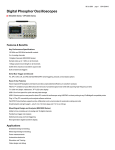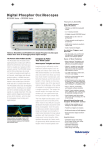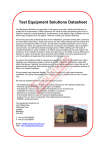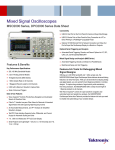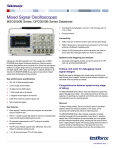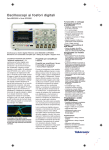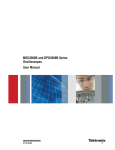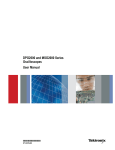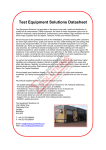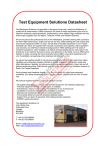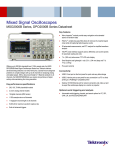Download TEKTRONIX DPO2024 Datasheet
Transcript
Test Equipment Solutions Datasheet Test Equipment Solutions Ltd specialise in the second user sale, rental and distribution of quality test & measurement (T&M) equipment. We stock all major equipment types such as spectrum analyzers, signal generators, oscilloscopes, power meters, logic analysers etc from all the major suppliers such as Agilent, Tektronix, Anritsu and Rohde & Schwarz. We are focused at the professional end of the marketplace, primarily working with customers for whom high performance, quality and service are key, whilst realising the cost savings that second user equipment offers. As such, we fully test & refurbish equipment in our in-house, traceable Lab. Items are supplied with manuals, accessories and typically a full no-quibble 2 year warranty. Our staff have extensive backgrounds in T&M, totalling over 150 years of combined experience, which enables us to deliver industry-leading service and support. We endeavour to be customer focused in every way right down to the detail, such as offering free delivery on sales, covering the cost of warranty returns BOTH ways (plus supplying a loan unit, if available) and supplying a free business tool with every order. As well as the headline benefit of cost saving, second user offers shorter lead times, higher reliability and multivendor solutions. Rental, of course, is ideal for shorter term needs and offers fast delivery, flexibility, try-before-you-buy, zero capital expenditure, lower risk and off balance sheet accounting. Both second user and rental improve the key business measure of Return On Capital Employed. We are based near Heathrow Airport in the UK from where we supply test equipment worldwide. Our facility incorporates Sales, Support, Admin, Logistics and our own in-house Lab. All products supplied by Test Equipment Solutions include: - No-quibble parts & labour warranty (we provide transport for UK mainland addresses). - Free loan equipment during warranty repair, if available. - Full electrical, mechanical and safety refurbishment in our in-house Lab. - Certificate of Conformance (calibration available on request). - Manuals and accessories required for normal operation. - Free insured delivery to your UK mainland address (sales). - Support from our team of seasoned Test & Measurement engineers. - ISO9001 quality assurance. Test equipment Solutions Ltd Unit 8 Elder Way Waterside Drive Langley Berkshire SL3 6EP T: +44 (0)1753 596000 F: +44 (0)1753 596001 Email: [email protected] Web: www.TestEquipmentHQ.com 06 Oct 2008 page 1 3GW-22048-0 Digital Phosphor Oscilloscopes MSO2000 Series • DPO2000 Series Features & Benefits Key Performance Specifications 100 MHz and 200 MHz bandwidth models 2 or 4 analog channels 16 digital channels (MSO2000 Series) Sample rates up to 1 GS/s on all channels 1 Mega sample record length on all channels 5,000 wfm/s maximum waveform capture rate Suite of advanced triggers Serial Bus Trigger and Decode I2C, SPI, CAN, LIN, and RS-232/422/485/UART serial triggering, decode, and analysis options Ease of Use Features Wave Inspector® Navigation and Search provides unprecedented efficiency in waveform analysis FilterVu™ variable low-pass filter allows for removal of unwanted signal noise while still capturing high-frequency events 7 in (180 mm) bright, widescreen, TFT-LCD color display USB 2.0 on front panel for quick and easy data storage USB 2.0 device port on rear panel for direct PC control of oscilloscope using USBTMC or direct printing to any PictBridge® compatible printer Plug ‘n’ Play PC connectivity and analysis software solutions TekVPI® Probe Interface supports active, differential, and current probes for automatic scaling and units Small footprint and light weight – only 5.3 in (134 mm) deep and 7 lb 14 oz (3.6 kg) Mixed Signal Design and Analysis (MSO2000 Series) Ability to time correlate up to 4 analog and 16 digital channels Parallel bus trigger and analysis Multichannel setup and hold triggering Next-generation digital waveform display Applications Embedded design and debug Mixed signal design and debug Power measurements Automotive electronics Education and Training Video design and debug 06 Oct 2008 page 2 3GW-22048-0 Tektronix MSO2000 and DPO2000 Series Digital Phosphor Oscilloscopes Feature-Rich Tools for Debugging Mixed Signal Designs The Power to Solve Problems Quickly - The MSO2000 and DPO2000 Series digital phosphor oscilloscopes (DPOs) deliver the performance and tools you need to visualize your signals and find answers quickly. The DPO2000 Series are the first oscilloscopes to provide 1 M points of usable record length on all channels, serial trigger and decode analysis options, a variable low-pass filter that also allows you to see signal details to the oscilloscope’s full bandwidth and all in a compact form factor. The MSO2000 Series adds 16 integrated digital channels, enabling you to visualize and time correlate analog and digital signals on a single instrument. This integration extends triggering functionality across all 20 channels – which is ideal for debugging mixed analog and digital designs. Digital phosphor technology enables 5,000 waveforms/second waveform capture and real-time intensity grading on the MSO2000 and DPO2000 Series Designed to Make Your Work Easier Wave Inspector® Navigation and Search Imagine trying to efficiently use the Internet if search engines such as Google and Yahoo didn’t exist and Web browser features such as Favorites and Links didn’t exist. Now you know how most modern oscilloscope users feel when trying to use the long record length in their digital oscilloscope. Record length, one of the key specifications of an oscilloscope, is the number of samples it can digitize and store in a single acquisition. The longer the record length, the longer the time window you can capture with high timing resolution (high sample rate). The first digital oscilloscopes could capture and store only 500 points, which made it very difficult to acquire all relevant information around the event being investigated. Over the years, oscilloscope vendors have provided longer and longer record lengths to meet market demands for long capture windows with high resolution. These mega-point record lengths often represent thousands of screens worth of signal activity. While standard record lengths have increased greatly over the years and can now satisfy the vast majority of applications in the marketplace, tools for effectively and efficiently viewing, navigating, and analyzing long record length acquisitions have been sorely neglected until now. The Tektronix MSO/DPO2000 Series redefines expectations for working with long record lengths with the following innovative Wave Inspector controls: Wave Inspector controls provide unprecedented efficiency in viewing, navigating, and analyzing waveform data. Zip through your 1 M point record by turning the outer pan control (1). Get from the beginning to end in seconds. See something of interest and want to see more details? Just turn the inner zoom control (2). Zoom/Pan – A dedicated, two-tier front-panel control provides intuitive control of both zooming and panning. The inner control adjusts the zoom factor (or zoom scale); turning it clockwise activates zoom and goes to progressively higher zoom factors, while turning it counterclockwise results in lower zoom factors and eventually turning zoom off. The outer control pans the zoom box across the waveform to quickly get to the portion of the waveform you are interested in. The outer control also utilizes force-feedback to determine how fast to pan on the waveform. The farther you turn the outer control, the faster the zoom box moves. Pan direction is changed by simply turning the control the other way. No longer do you need to navigate through multiple menus to adjust your zoom view. Play/Pause – A dedicated play/pause button on the front panel scrolls the waveform across the display automatically while you look for anomalies or an event of interest. Playback speed and direction are controlled using the intuitive pan control. Once again, turning the control further makes the waveform scroll faster and changing direction is as simple as turning the control the other way. 06 Oct 2008 page 3 3GW-22048-0 User Marks – See something interesting on your waveform? Press the Set Mark button on the front panel to leave one or more “bookmarks” on the waveform. Navigating between marks is as simple as pressing the Previous (←) and Next (→) buttons on the front panel. Search Marks – Don’t want to take the time to inspect the entire acquisition manually to find the event you’re looking for? The MSO/DPO2000 Series features a robust automatic waveform search feature that allows you to search through your long acquisition based on user-defined criteria. All occurrences of the event are highlighted with search marks and are easily navigated to, using the front-panel Previous (←) and Next (→) buttons. Search types include edge, pulse width, runt, logic, setup and hold, rise/fall time and parallel, I2C, SPI, RS-232/422/485/UART, CAN, and LIN packet content. Search step 1: You define what you would like to find Search step 2: MSO/DPO2000 automatically searches through the record and marks each event with a hollow white triangle Search step 3: Use previous and next buttons to jump from one event to the next 1. Zoom/Pan – Dedicated front-panel controls for zooming and panning. Get from the start to the end of your 1 M record in seconds. The inner control adjusts the zoom factor while the outer ring adjust pans the zoom box across the waveform. Navigating your waveform has never been easier. 2. Marks – Want to mark your waveform for future reference or for quick navigation between events of interest? Simply press the Set Mark button to place “bookmarks” on your waveform. Use the next and previous buttons to navigate through user marks and search generated marks. 3. Search – Tired of turning the horizontal position control endlessly on your current scope to find the event you’re looking for? Use the MSO/DPO2000’s powerful Search feature to automatically find and mark all occurrences of an event based on user specified criteria. Search types include edge, pulse width, runt, logic, multichannel setup and hold, rise/fall time and I2C, SPI, CAN, LIN, and RS-232/422/485/UART packet content. 4. 2 or 4 Analog Channels and 16 Digital Channels – View and trigger on up to 20 time-correlated signals on the same display. (16 Digital Channels on MSO models only.) 5. Parallel and Serial Buses – Trigger on parallel or serial packet level content, view acquired data as a bus with all data decoded into hex, binary, or ASCII, search through acquisitions for specific content and even view all decoded data in a tabular format, much like you would see on a logic analyzer. Standards supported include I2C, SPI, CAN, LIN, and RS-232/422/485/UART. Analyze up to two buses at the same time. (Parallel is available on MSO models only.) 6. Dedicated Vertical Controls – Vertical controls provide simple and intuitive operation. No longer do you need to share one set of vertical controls across all four channels. 06 Oct 2008 page 4 3GW-22048-0 7. Large Widescreen, digital phosphor display – The MSO/DPO2000 Series boasts a bright, 7 inch (180 mm), widescreen display. Discover and troubleshoot design problems faster with 5,000 waveforms/second continuous waveform capture rate and real-time intensity grading. Continuous high waveform capture rate saves time by quickly revealing the nature of faults so advanced triggers can be applied to isolate them. Real-time intensity grading exposes the “history” of a signal’s activity as they accumulate. The digital phosphor display makes its easier to understand the characteristics of the transients you have captured. It intensifies the areas where the signal trace occurs more frequently. 8. FilterVu™ Variable Low-Pass Filter – Tired of dealing with unwanted noise on your signal? Ever wished your oscilloscope had bandwidth limiters below 20 MHz? Simply turn on FilterVu and adjust the variable low-pass noise filter. Unlike other variable low pass filters, FilterVu filters out the unwanted noise from your signal while still capturing glitches and other signal details up to the full bandwidth of the oscilloscope. FilterVu is ideal for repetitive, single-shot, and nonrepetitive events. 9. Serial Trigger and Decode Application Module – MSO/DPO2000 Series have 2 slots for application modules. Application specific modules extend how you use your oscilloscope by adding serial bus triggering and decode. DPO2AUTO – Automotive serial bus triggering and decode with support for CAN and LIN buses. DPO2COMP- Computer bus serial triggering and decode with support for RS-232/422/485/UART buses. DPO2EMBD – Embedded bus serial triggering and decode with support for I2C and SPI buses. 10. USB – Use the front-panel USB host port for simple and convenient storage of screenshots, waveform data, and oscilloscope setups. Use the rear-panel USB device port to easily communicate and control your oscilloscope from a PC. Or use the rear-panel USB device port to directly print your screen image to any PictBridge® compatible printer. 11. TekVPI® – TekVPI probe interface provides for direct-connect current probes, intuitive comp box controls, remote control of probe settings, and smarter communication between the oscilloscope and the probe. Optional LAN and VGA video ports! – Connect your oscilloscope to your network to remotely control and collect data. Display your screen on an external monitor or projector. Only 5.3 inches deep! – Free up valuable space on your bench or desktop. See the MSO/DPO2000 Series in action for yourself. Try out the MSO/DPO2000 Virtual Oscilloscope at: www.tektronix.com/mso2000 Serial Triggering and Analysis One of the most common applications requiring long record length is serial data analysis in embedded system design. Embedded systems are virtually everywhere. They can contain many different types of devices including microprocessors, microcontrollers, DSPs, RAM, EEPROMs, FPGAs, ADCs, DACs, and I/O. These various devices have traditionally communicated with each other and the outside world using wide parallel buses. Today, however, more 06 Oct 2008 page 5 3GW-22048-0 and more embedded systems are replacing these wide parallel buses with serial buses due to lower board space requirements, fewer pins, lower power, embedded clocks, differential signaling for better noise immunity and most importantly, lower cost. In addition, there’s a large supply of off-the-shelf building block components from reputable manufacturers, enabling rapid design development. While serial buses have a large number of benefits, they also present significant challenges that their predecessors (parallel buses) did not face. They make debugging bus and system problems more difficult, it’s harder to isolate events of interest and it’s more difficult to interpret what is displayed on the oscilloscope screen. The MSO2000 and DPO2000 Series address these challenges and represent the ultimate tool for engineers working with serial buses such as I2C, SPI, RS-232/422/485/UART, CAN, and LIN. MSO/DPO2000 triggered on a specific data packet going across an I2C bus. No more counting clock edges and 1s and 0s. A Bus waveform provides decoded packet content including Start, Address, Read/Write, Data, and Stop. And the addition of timing waveforms makes it easy to quickly determine values of two signals. Bus Display – Provides a higher level, combined view of the individual signals (clock, data, chip enable, etc.) that make up your bus, making it easy to identify where packets begin and end and identifying sub-packet components such as address, data, identifier, CRC, etc. Serial Triggering – Trigger on packet content such as start of packet, specific addresses, specific data content, unique identifiers, etc., on popular serial interfaces – I2C, SPI, RS-232/422/485/UART, CAN, and LIN. Bus Decoding – Tired of having to visually inspect the waveform to count clocks and determine if each bit is a 1 or a 0, and then combine bits into bytes and determine the hex value? Let the oscilloscope do it for you! Once you’ve set up a bus, the oscilloscope will decode each packet on the bus and display the value in either hex, binary, decimal (LIN only), or ASCII (RS-232/422/485/UART only) in the bus waveform. Event Table – In addition to seeing decoded packet data on the bus waveform itself, you can view all captured packets in a tabular view much like you would see on a logic analyzer. Packets are time-stamped and listed consecutively with columns for each component (Address, Data, etc.). The event table can also be exported for use offline. Search – Serial triggering is very useful for isolating an event of interest, but once you’ve captured it and need to analyze the surrounding data, what do you do? In the past, you had to manually scroll through the waveform, counting and converting bits and looking for what caused the event. With the MSO2000 and DPO2000 Series, you can have the oscilloscope automatically search through the acquired data for user-defined criteria including serial packet content. Each occurrence is marked for easy reference. Rapid navigation between marks is as simple as pressing the Previous (←) and Next (→) buttons on the front panel. The P6316 digital probe for MSO2000 Series simplifies connection to the device-under-test Mixed Signal Design and Analysis (MSO2000 Series) As an embedded-design engineer, you are faced with the challenge of ever-increasing system complexity. A typical embedded design may incorporate various analog signals, high- and low-speed serial digital communication and microprocessor buses, just to name a few. Serial protocols such as I 2C and SPI are used 06 Oct 2008 page 6 3GW-22048-0 frequently for chip-to-chip communication, but parallel buses are still used in many applications. Microprocessors, FPGAs, Analog-to-Digital Converters (ADCs), and Digital-to-Analog Converters (DACs) are all examples of ICs that present unique measurement challenges in today’s embedded designs. The MSO2000 Series Mixed Signal Oscilloscopes offer the addition of 16 digital channels. These channels are tightly integrated into the oscilloscope’s user interface, simplifying operation and making it possible to solve mixed signal issues easily. Next Generation Digital Waveform Display In a continued effort to make mixed signal oscilloscopes easy to use, the MSO2000 Series has redefined the way you view digital waveforms. One common problem shared by both logic analyzers and mixed signal oscilloscopes is determining if data is a one or a zero when zoomed in far enough that the digital trace stays flat all the way across the display. The MSO2000 has color-coded the digital traces, displaying ones in green and zeros in blue. In addition, the MSO2000 displays white edges around the transition points of digital channels when there is uncertainty between sample points. This acts as a visual reminder that increasing the sample rate on the next acquisition will reveal higher frequency information than your previous settings could acquire. Channel setup on an MSO can often be time consuming as compared to the traditional oscilloscope. This process often includes probing the device undertest, labeling the channels, and positioning the channels on screen. The MSO2000 simplifies this process by allowing the user to group digital waveforms and enter waveform labels using a USB keyboard. By simply placing digital waveforms next to each other, they form a group. Once a group is formed, you can position all the channels contained in that group together. This greatly reduces the normal setup time associated with positioning channels individually. P6316 MSO Probe This unique probe design offers two eight-channel pods and simplifies the process of connecting to the device-under-test. When connecting to square pins, the P6316 can connect directly to 8x2 square pin headers spaced on tenth-inch centers. When more attachment flexibility is required, you can use the included flying lead sets and grabbers to clip onto surface mount devices or test points. The P6316 offers outstanding electrical characteristics applying only 8 pF of loading with 101 kΩ input impedance. (Output of DAC Signal) Notice how FilterVu™ clearly shows the noise-free steps of the DAC in the foreground trace (yellow) which has removed all frequencies above 5.5 kHz. FilterVu also captures and displays high-frequency glitches up to the full bandwidth of the oscilloscope in the background trace (orange) 06 Oct 2008 page 7 3GW-22048-0 FilterVu™ Variable Low-Pass Filter Tired of being limited to a 20 MHz bandwidth filter in your oscilloscope? Simply turn on FilterVu and adjust the variable low-pass noise filter. Unlike other variable low-pass filters, FilterVu filters out the unwanted noise from your signal while still capturing glitches and other signal details up to the full bandwidth of the oscilloscope. It does this by showing two waveforms: a waveform that can be filtered (foreground waveform) and a glitch capture waveform (background waveform). The filtered waveform uses a variable low-pass filter to block out noise, yielding a cleaner waveform to more precisely locate signal edges and amplitude levels. The result is improved confidence in you cursor measurements and cleaner documentation of important signal attributes. When the noise filter is adjusted to the lowest available noise cutoff frequency, no more than 1% of high-frequency content that could cause the oscilloscope to alias will pass through the filter. The glitch capture waveform shows signal details up to the full bandwidth of the oscilloscope. The oscilloscope captures pulses as narrow as 5 ns, using peak detect min/max sampling, protecting you from missing unexpected glitches or other high-frequency events. FilterVu is ideal for repetitive, nonrepetitive, and single-shot events. Easily capture, save, and analyze measurement results. PC Connectivity and USB Data Storage The MSO2000 and DPO2000 Series provides flexibility in data transfer with standard USB host and device ports which enable removable data storage, seamless PC connectivity, and direct printing. Also available are optional GPIB, LAN, and Video-Out adaptors. Easily capture, save, and analyze measurement results with OpenChoice® Desktop PC Communications software. Simply pull screen images and waveform data into the stand-alone desktop application or directly in Microsoft Word and Excel. To complement OpenChoice, National Instruments LabVIEW SignalExpress™ Tektronix Edition software provides you with extended capabilities, including advanced analysis, remote oscilloscope control, and live waveform analysis. Alternatively, if you prefer not to use the PC, you can simply print your image directly to any PictBridge® compatible printer using the USB device port. OpenChoice® Desktop – Standard software seamlessly connects the oscilloscope to a PC. 06 Oct 2008 page 8 3GW-22048-0 NI LabVIEW SignalExpress™ Tektronix Edition – Fully interactive measurement acquisition and analysis software developed jointly with National Instruments, and optimized for the MSO/DPO2000 Series e*Scope enables control of your network connected oscilloscope from any network connected PC through a traditional browser interface TekVPI® Probing The TekVPI probe interface sets the standard for ease of use in probing. TekVPI probes feature status indicators and controls, as well as a probe menu button right on the input compensation box itself. This button brings up a probe menu on the oscilloscope display with all relevant settings and controls for the probe. The TekVPI interface utilizes a new probe power management architecture enabling direct attachment of current probes (Requires TekVPI External Power Supply – Tektronix Part number: 119-7465-xx). Finally, TekVPI probes can be controlled remotely by using USB, GPIB, or Ethernet, enabling more versatile solutions in ATE environments. Characteristics Vertical System – Analog Channels Vertical System Analog Channels Input Channels Analog Bandwidth*1 (-3 dB) Calculated Rise Time Hardware Bandwidth Limits Input Coupling Input Impedance Input Sensitivity Range Vertical Resolution Max Input Voltage DC Gain Accuracy (with offset set to 0 V) Offset Range 2 mV/div to 200 mV/div >200 mV/div to 5 V/div Channel-to-Channel Isolation (Any Two Channels at Equal Vertical Scale) *1 Bandwidth is 20 MHz at 2 mV/div, all models MSO2012 DPO2012 MSO2014 DPO2014 MSO2024 DPO2024 2 100 MHz 3.5 ns 4 4 100 MHz 200 MHz 3.5 ns 2.1 ns 20 MHz AC, DC, GND 1 MΩ ±2%, 11.5 pF ±2 pF 2 mV/div to 5 V/div 8 bits 300 VRMS with peaks ≤450 V ±3% for 10 mV/div to 5 V/div, ±4% for 2 mV/div to 5 mV/div ±1 V ±25 V ≥100:1 at ≤100 MHz ≥100:1 at ≤200 MHz 06 Oct 2008 page 9 3GW-22048-0 Vertical System – Digital Channels MSO2012 Input Channels Thresholds Threshold Selections User Defined Threshold Range Maximum Input Voltage Threshold Accuracy Maximum Input Dynamic Range Minimum Voltage Swing Input Impedance Probe Loading Vertical Resolution MSO2014 MSO2024 16 Digital (D15 to D0) Threshold per set of 8 channels TTL, CMOS, ECL, PECL, User Defined ±20 V ±40 V ±(100 mV + 3% of threshold setting) 80 Vpk-pk (threshold setting dependent) 500 mVpk-pk 101 kΩ 8 pF 1 bit Horizontal System – Analog Channels MSO2012 DPO2012 Maximum Sample Rate (all channels) Minimum Peak Detect Pulse Width Maximum Record Length (all channels) Maximum Duration of Time Captured at Highest Sample Rate (all channels) Timebase Range Timebase Delay Time Range Channel-to-Channel Deskew Range Timebase Accuracy MSO2014 DPO2014 MSO2024 DPO2024 1 GS/s 7.0 ns 3.5 ns 1 M points 1 ms 4 ns to 100 s -10 div to 5000 s ±100 ns ±25 ppm 2 ns to 100 s Horizontal System – Digital Channels MSO2012 Maximum Sample Rate (when using any of channels D7-D0) Maximum Sample Rate (when using any of channels D15-D8) Maximum Record Length Minimum Detectable Pulse Width Channel-to-Channel Skew MSO2014 MSO2024 1 GS/s (1 ns resolution) 500 MS/s (2 ns resolution) 1 M points 5 ns 2 ns typical Acquisition Modes Sample – Acquires sampled values Peak Detect – Captures glitches as narrow as 3.5 ns at all sweep speeds Averaging – From 2 to 512 waveforms included in average Roll – Scrolls waveforms right to left across screen at sweep speeds slower than or equal to 40 ms/div Trigger System Main Trigger Modes – Auto, Normal, and Single Trigger Coupling – DC, HF reject (attenuates >85 kHz), LF reject (attenuates <65 kHz), noise reject (reduces sensitivity) Trigger Holdoff Range – 20 ns to 8 s Trigger Signal Frequency Counter – Provides a higher accuracy means of identifying the frequency of trigger signals. Trigger Signal Frequency counter resolution is 6 digits. 06 Oct 2008 page 10 3GW-22048-0 Sensitivity Internal DC Coupled Trigger Source Sensitivity Analog Inputs 0.4 division from DC to 50 MHz 0.6 divisions >50 MHz to 100 MHz 0.8 divisions >100 MHz to 200 MHz 200 mV from DC to 100 MHz, 1x attenuation External (Auxiliary Input) Trigger Level Range Any Channel – ±4.92 divisions from center of screen External (auxiliary input) – ±6.25V, 1x attenuation; ±12.5V, 10x attenuation Trigger Modes Edge – Positive or negative slope on any channel or front-panel auxiliary input. Coupling includes DC, HF reject, LF reject, and noise reject. Pulse Width – Trigger on width of positive or negative pulses that are >, <, =, or ≠ to a specified period of time. Runt – Trigger on a pulse that crosses one threshold but fails to cross a second threshold before crossing the first again. Logic – Trigger when any logical pattern of channels goes false or stays true for specified period of time. Any input can be used as a clock to look for the pattern on a clock edge. Pattern (AND, NAND) specified for all analog and digital input channels defined as High, Low, or Don’t Care. Setup and Hold – Trigger on violations of both setup time and hold time between clock and data present on any of the input channels. Rise/Fall Time – Trigger on pulse edge rates that are faster or slower than specified. Slope may be positive, negative, or either. Video – Trigger on line number, all lines, odd, even, or all fields on NTSC, PAL, and SECAM video signals. I2C (Optional) – Trigger on Start, Repeated Start, Stop, Missing ACK, Address (7 or 10 bit), Data, or Address and Data on I2C buses up to 3.4 Mb/s. SPI (Optional) – Trigger on SS, Idle Time, MOSI, MISO, or MOSI and MISO on SPI buses up to 10.0 Mb/s. CAN (Optional) – Trigger on Start of Frame, Frame Type (data, remote, error, overload), Identifier (standard or extended), Data, Identifier and Data, End of Frame, Missing ACK, or Bit Stuffing Errors on CAN signals up to 1 Mb/s. Data can be further specified to trigger on ≤, <, =, >, ≥ or ≠ a specific data value. User-adjustable sample point is set to 50% by default. RS-232/422/485/UART (Optional) – Trigger on Tx start bit, Rx start bit, Tx end of packet, Rx end of packet, Tx data, Rx data, Tx Parity Error, and Rx Parity Error. LIN (Optional) – Trigger on Sync, Identifier, Data, Identifier and Data, Wakeup Frame, Sleep Frame, or Errors such as Sync Parity or Checksum Errors. Parallel (available on MSO models only) – Trigger on a parallel bus data value. Waveform Measurements Cursors – Waveform and Screen Automatic Measurements – 29, of which up to four can be displayed on screen at any one time. Measurements include Frequency, Period, Delay, Rise Time, Fall Time, Positive Duty Cycle, Negative Duty Cycle, Positive Pulse Width, Negative Pulse Width, Burst Width, Phase, Positive Overshoot, Negative Overshoot, Peak to Peak, Amplitude, High, Low, Max, Min, Mean, Cycle Mean, RMS, Cycle RMS, Positive Pulse Count, Negative Pulse Count, Rising Edge Count, Falling Edge Count, Area, and Cycle Area Gating – Isolate the specific occurrence within an acquisition to take measurements, using either the screen or waveform cursors Waveform Math Arithmetic – Add, subtract, and multiply waveforms Software NI LabVIEW SignalExpress™ Tektronix Edition LE – A fully interactive measurement software environment optimized for the MSO2000/DPO2000 Series, enables you to instantly acquire, generate, analyze, compare, import, and save measurement data and signals using an intuitive drag-and-drop user interface that does not require any programming. Standard MSO2000/DPO2000 Series support for acquiring, controlling, viewing, and exporting your live signal data is permanently available through the software. The full version (SIGEXPTE) adds additional signal processing, advanced analysis, mixed signal, sweeping, limit testing, and user-defined step capabilities and is available for a 30-day trial period standard with each instrument OpenChoice® Desktop – Enables fast and easy communication between a Windows PC and the MSO2000/DPO2000 Series, using USB or LAN. Transfer and save settings, waveforms, measurements, and screen images IVI Driver – Provides a standard instrument programming interface for common applications such as LabVIEW, LabWindows/CVI, Microsoft .NET and MATLAB Display Characteristics Display Type – 7 in (180 mm) liquid crystal TFT color display Display Resolution – 480 horizontal x 234 vertical pixels (WQVGA) Waveform Styles – Vectors, Dots (In Video Trigger mode), Variable Persistence, Infinite Persistence 06 Oct 2008 Graticules – Full, Grid, Cross Hair, Frame Format – YT and XY Waveform Capture Rate – Up to 5,000 wfms/sec Input/Output Ports USB 2.0 High-Speed Host Port – Supports USB data storage devices and keyboards USB 2.0 High-Speed Device Port – Rear-panel port supports communication/control of oscilloscope by PC and all PictBridge® compatible printers LAN Port – RJ-45 connector, supports 10/100Base-T (requires DPO2CONN) GPIB – Adapt USB 2.0 device port to a GPIB port (requires TEK-USB-488) Video Out Port – DB-15 female connector, connect to show the oscilloscope display on an external monitor or projector (requires DPO2CONN) Auxiliary Input – Front-panel BNC connector. Input Impedance 1 MΩ ±2%. Max input 300 VRMS with peaks ±450 V Probe Compensator Output – Front-panel pins, Amplitude 5.0 V, Frequency 1 kHz Kensington Lock – Rear-panel security slot connects to standard Kensington style lock PowerSource Power Source Voltage – 100 to 240 V ±10% PowerSource Frequency – 45 to 65 Hz (90 to 264 V) 360 to 440 Hz (100 to 132 V) Power Consumption – 80 W maximum TekVPI External Power Supply (119-7465-xx) – Output voltage: 12 V; Output current: 4.2 A; Power consumption: 50 W Physical Characteristics Dimensions mm in Height Width Depth 180 377 134 7.1 14.9 5.3 Weight kg lb Net Shipping 3.6 6.2 7.9 13.7 Rackmount Configuration – 4 U Cooling Clearance - 50 mm (2 inches) on the left side and rear (when looking at the front of the instrument) General Characteristics Environmental Temperature Operating – 0 °C to +50 °C Nonoperating – -40 °C to +71 °C Humidity Operating – High: 30 °C to 50 °C, 5% to 60% Relative Humidity Low: 0 °C to 30 °C, 5% to 95% Relative Humidity Nonoperating – High: 30 °C to 55 °C, 5% to 60% Relative Humidity Low: 0 °C to 30 °C, 5% to 95% Relative Humidity Altitude Operating – 3,000 meters (9,843 feet) Nonoperating – 12,000 meters (39,370 feet) Random Vibration Operating – 0.31 GRMS from 5 to 500 Hz, 10 minutes each axis, 3 axes, 30 minutes total Nonoperating – 2.46 GRMS from 5 to 500 Hz, 10 minutes each axis, 3 axes, 30 minutes total page 11 3GW-22048-0 06 Oct 2008 page 12 3GW-22048-0 Regulatory Electromagnetic Compatibility – 2004/108/EC Safety – Listed UL61010–1: 2004, CAN/CSA-C22.2 No. 61010.1: 2004; Complies with EN61010–1: 2001, Complies with the Low Voltage Directive 2004/108/EC for Product Safety Ordering Information MSO2000 Models MSO2012 – 100 MHz, 1 GS/s, 1 M record length, 2+16 channel mixed signal oscilloscope MSO2014 – 100 MHz, 1 GS/s, 1 M record length, 4+16 channel mixed signal oscilloscope MSO2024 – 200 MHz, 1 GS/s, 1 M record length, 4+16 channel mixed signal oscilloscope DPO2000 Models DPO2012 – 100 MHz, 1 GS/s, 1 M record length, 2-channel digital phosphor oscilloscope DPO2014 – 100 MHz, 1 GS/s, 1 M record length, 4-channel digital phosphor oscilloscope DPO2024 – 200 MHz, 1 GS/s, 1 M record length, 4-channel digital phosphor oscilloscope All models include: One P2221 200 MHz, 1x/10x Passive Probe per Analog Channel, User Manual and Translated Front-Panel Overlay, Documentation CD (063-4118-xx), OpenChoice® Desktop Software, NI LabVIEW SignalExpress™ Tektronix Edition LE Software, Calibration certificates document measurement traceability to National Metrology Institute(s) and ISO9001 Quality System Registration, Power Cord, and a three-year warranty. MSO models also include one P6316 16-channel logic probe and accessory kit, and accessory bag (016-2008-xx) Please specify power plug and manual version when ordering Recommended Serial Bus Application Modules DPO2EMBD – Embedded Serial Triggering and Analysis Module. Enables triggering on packet level information on I2C and SPI buses as well as analytical tools such as bus views, packet decoding, search tools, and packet decode tables with timestamp information DPO2COMP – Computer Serial Triggering and Analysis Module. Enables triggering on packet level information on RS-232/422/485/UART buses as well as analytical tools such as bus views, packet decoding, search tools, and packet decode tables with timestamp information DPO2AUTO – Automotive Serial Triggering and Analysis Module. Enables triggering on packet level information on CAN and LIN buses as well as analytical tools such as bus views, packet decoding, search tools, and packet decode tables with timestamp information Options International Power Plugs Opt. A0 – North America power. Opt. A1 – Universal EURO power. Opt. A2 – United Kingdom power. Opt. A3 – Australia power. Opt. A5 – Switzerland power. Opt. A6 – Japan power. Opt. A10 – China power. Opt. A11 – India power. Opt. A99 – No power cord or AC adapter. Language Options*1 Opt. L0 – English manual. Opt. L1 – French manual. Opt. L2 – Italian manual. Opt. L3 – German manual. Opt. L4 – Spanish manual. Opt. L5 – Japanese manual. Opt. L6 – Portuguese manual. Opt. L7 – Simplified Chinese manual. Opt. L8 – Standard Chinese manual. Opt. L9 – Korean manual. Opt. L10 – Russian manual. Opt. L99 – No manual. Service Options*2 Opt. C3 – Calibration Service 3 years. Opt. C5 – Calibration Service 5 years. Opt. CA1 – Provides a single calibration event, or coverage for the designated calibration interval, whichever comes first. Opt. D1 – Calibration Data Report. 06 Oct 2008 page 13 Opt. D3 – Calibration Data Report 3 years (with Opt. C3). Opt. D5 – Calibration Data Report 5 Years (with Opt. C5). Opt. R5 – Repair Service 5 years (including warranty). Recommended Probes TAP1500*3 – 1.5 GHz TekVPI single-ended active probe. TDP0500*3, *5 – 500 MHz TekVPI 42 V differential probe. TCP0030*3 – 120 MHz TekVPI 30 Ampere AC/DC current probe. TCP0150*3 – 20 MHz TekVPI 150 Ampere AC/DC current probe. TCPA300/400*6 – Current measurement system amplifiers. TCP305 – DC to 50 MHz, 50 A current probe for use with TCPA300. TCP404XL – DC to 2 MHz, 500 A current probe for use with TCPA400. P5100 – 2.5 kV, 100X high-voltage passive probe. P5200 – 1.3 kV, 50X/500X, 25 MHz high-voltage active differential probe. P5205*3, *4 – 1.3 kV, 100 MHz high-voltage differential probe. P5210*3, *4 – 5.6 kV, 50 MHz high-voltage differential probe. ADA400A*3, *4 – 100x, 10x, 1x, 0.1x high-gain differential amplifier. Recommended Accessories DPO2CONN – Adds Ethernet (10/100Base-T) and Video Out Port. Service manual – Order 071-2331-xx (English only). TPA-BNC*3 – TekVPI to TekProbe BNC Adapter. TekVPI External Power Supply – Order 119-7465-xx. TEK-USB-488 – GPIB to USB Adapter. Digital Probe Leadset (8 Channels) – Order 196-3508-xx. TEK-DPG*3 – TekVPI Deskew Pulse Generator Signal Source. Deskew and Calibration Fixture – Order 067-1686-xx. Rackmount Kit – Order RMD2000. Does not include slide-out rails. Soft Transit Case and Front Protective Cover – Order ACD2000. Front Protective Cover – Order 200-5045-xx. Hard Transit Case – Order HCTEK4321 (Requires ACD2000). SIGEXPTE – NI LabVIEW SignalExpress™ Tektronix Edition Software (Full Version). USB Keyboard – Order 119-7083-00. Soft carrying case with front protective cover for MSO2000 and DPO2000 Series (ACD2000) Warranty Three-year warranty covering all parts and labor, excluding probes. *1 Language options include translated front-panel overlay for the selected language(s) *2 Probes and accessories are not covered by the oscilloscope warranty and Service Offerings. Refer to the datasheet of each probe and accessory model for its unique warranty and calibration terms *3 Requires TekVPI external power adapter (119-7465-00); one per oscilloscope *4 Requires TPA-BNC adapter *5 Probes terminate into 50 Ω but oscilloscope will automatically adjust to account for 1 MΩ input *6 Requires 50 Ω feed through termination between the oscilloscope input and the BNC cable Product(s) are manufactured in ISO registered facilities. Product(s) complies with IEEE Standard 488.1-1987, RS-232-C, and with Tektronix Standard Codes and Formats. 3GW-22048-0














